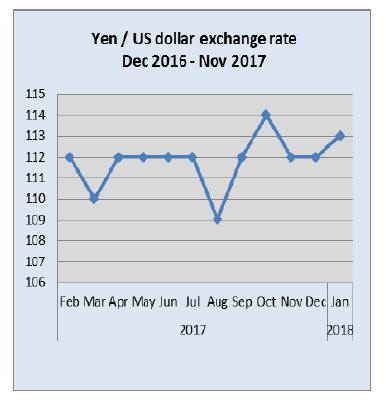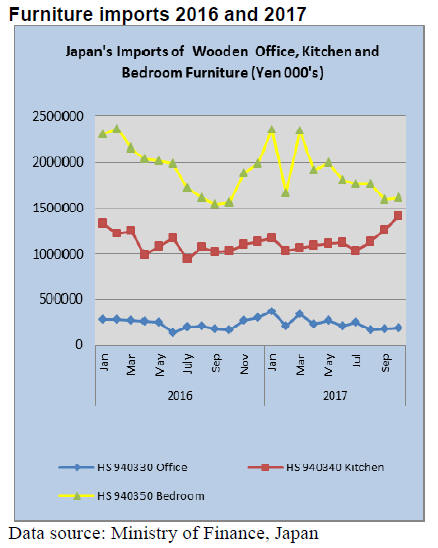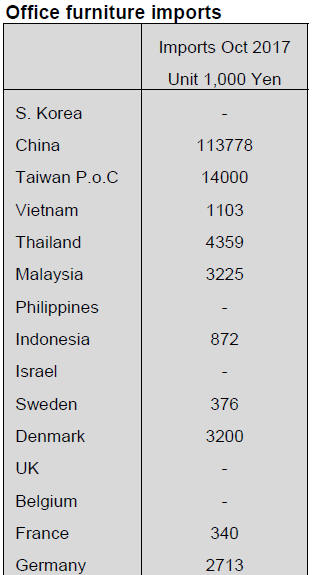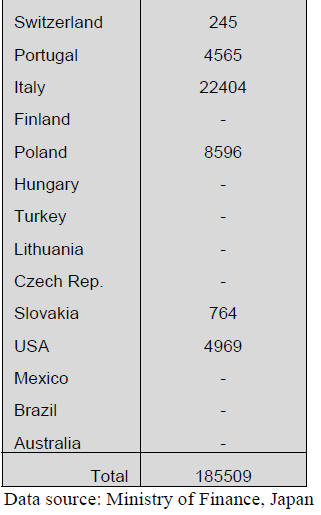Japan
Wood Products Prices
Dollar Exchange Rates of 10th
January
2018
Japan Yen 111.26
Reports From Japan
Second longest post war
economic expansion
In a survey conducted towards the end of 2017 most large
Japanese companies indicated that they expect the
Japanese economy to expand further in 2018 on the back
of increased capital investment a recovery in individual
consumption and faster export growth.
As the New Year begins the government has been
heartened by data showing the Japanese economy is in its
second longest post war economic expansion with
indications that the good news will continue into 2019
provided international demand remains robust.
Japan¡¯s GDP has grown for seven straight quarters and the
stock market is at a 25 year high but, despite good
corporate profits, consumer spending remains weak as
wage increase have not flowed from major companies.
The Spring wage negotiations are about to begin and
already the government is lobbying hard to get the major
companies to release some of their profit stock pile as
wage hikes.

Traders alert for any hint of a change in
the BoJ weak
yen policy
Over the extended year-end holidays the US dollar/yen
exchange rate barely changed as there were no significant
movements in the main economic indicators.
Housing starts in Japan continue to be firm as they are in
the US and there has been no movement in Japan¡¯s
manufacturing output or consumer spending which could
have triggered an exchange rate movement.
Looking further ahead there does seem to be an
expectation that the Bank of Japan (BoJ) will be
considering an interest rate increase during 2018 given
five successive quarters of economic expansion and a very
tight labour market.
The weak yen is the biggest boost to exports and adds
some inflationary pressure because imports are that much
more expensive. A stronger yen would have the opposite
effect on export growth and inflation. Several analysts are
cautioning that currency traders remain alert to any hint of
a change in the BoJ policy and that we may see a period of
volatility in the yen/dollar exchange rate in 2018.

Second half robust housing market continues
Data from Japan¡¯s Ministry of Land, Infrastructure,
Transport and Tourism shows that November 2017
housing starts, while flat month on month, rose around 2%
year on year. On the basis of the past 11 months 2017
annual starts are likely to come in at around 960,000.
Construction companies continue to report firm order book
positions and Ministry data shows orders received by the
top builders rose sharply in November, adding to the rise
reported for October orders.

Japan¡¯s wooden furniture imports
The cyclical trend in bedroom furniture imports has once
again been repeated in 2017. After peaking in the Spring
Japan¡¯s imports of wooden bedroom furniture traditionally
drop back in the months to year end only to pick up once
again.
While the trend in bedroom furniture imports is following
a familiar pattern this is not the case with wooded kitchen
furniture. After moving within a narrow range for the past
2-3 years in the second half of 2017 imports of wooden
kitchen furniture have surged. This could be partly the
result of the flood of cash into buy-to-rent properties in
Japan, a tactic used to minimise inheritance taxes by the
wealthy.

Office furniture imports (HS 940330)
Japan¡¯s imports of wooden office furniture are small
compared to the value of wooden bedroom and kitchen
furniture imports.
Year on year, the value of October imports of wooden
office furniture was up 10% and compared to a month
earlier imports in October rose 6%. For the first 10 months
of 2017 wooden office furniture imports were around 6%
higher than over the same period in 2016.
Shippers in China accounted for over 60% of Japan¡¯s
wooden office furniture and along with shipments from
Italy and Taiwan P.o.C some 80% of all shipments were
accounted for.
 
Kitchen furniture imports (HS 940340)
The value of Japan¡¯s imports of wooden kitchen furniture
has been steadily rising since July and October marked
another high. However, despite the second half surge in
imports, the total value in the first 10 months of 2017 was
little different from that during the same period in 2016.
Closer examination of the import flow shows that in the
first half of 2017 imports were below average.
Year on year October 2017 imports were up 37% and
month on month there was a 12% rise in October 2017
from a month earlier. The combined shipments from the
Philippines, Vietnam and China once again account for
over 90% of all September shipments of wooden kitchen
furniture.
 
Bedroom furniture imports (HS 940350)
Japan¡¯s imports of wooden bedroom furniture continue the
familiar trend seen in past years of a steady decline in the
second half of the year with an expected up-tick in the
later months of the year and the early months of the New
Year.
October 2017 imports of wooden bedroom furniture were
up around 3% on levels in October the previous year and
month on month there was very little change which may
signal the traditional reversal of the decline in the second
half of each year. However, total imports over the 10
months to October 2017 are down slightly when compared
to the same period in 2016.
Shippers in China and Vietnam dominate Japan¡¯s imports
of wooden bedroom furniture accounting for 59% and
29% respectively. If shipments from Thailand and
Malaysia are included then some 95% of all wooden
bedroom furniture is accounted for.
 
Trade news from the Japan Lumber Reports (JLR)
For the JLR report please see:
http://www.nmokuzai.
com/modules/general/index.php?id=7
Government policy in relation to TPP
The government decided general policy in relation to TPP
(now termed the Comprehensive and Progressive
Agreement for Trans-Pacific Partnership). The prime
minister commented that supplementary budget for 2017
should be made based on the general policy for the
Ministry of Agriculture, Forestry and Fisheries.
Based on newly decided policy, 29 billion yen of
supplementary budget is allocated for strengthening
plywood and lumber industry which includes supporting
business of log production and logging road maintenance.
As to policy target for forest and wood industry,
strengthening of international competitive power of
plywood, lumber and laminated lumber are stressed. In the
concrete, lower production cost of wood products
including reduction of log producing cost then expand
share of domestic products are targeted.
Promotion to improve competitive power includes
efficient manufacturing facility, shifting to competitive
items, lowering log producing cost by efficient forest
management.
Concentrating budget allocation to the area where
efficient
forest management is possible is necessary by introducing
high performance harvesting machines and maintenance of
logging road system.
Plywood supply
Total plywood supply in October was 511,900 cbms, 4.0%
more than October last year and 4.0% more than
September.
Demand and supply of domestic plywood were very
active. Total domestic supply in October was 280,300
cbms out of which softwood plywood was 267,800 cbms,
6.5% more and 1.9% more. As monthly production of
softwood plywood, this exceeded past record of last June¡¯s
265,600 cbms and marked the highest record. Meantime,
the shipment of domestic plywood in October was 286,200
cbms, 4.8% more and 2.2% more.
Shipment of softwood plywood was 273,100 cbms, 5.8%
more and 2.1% more.
Besides robust demand of structural panels by precutting
plants, orders for non-structural panels such as floor base
has been increasing, which pushes high level production
and shipment. The softwood plywood inventories dropped
down to 88,200 cbms, 5,300 cbms less than September
end.
Imported plywood arrivals in October were 231,500 cbms,
1.5% more and 6.9% more. Both Malaysian and
Indonesian supply maintains the same level as last year
and total year supply would be the same as last year.
However, supply tightness of coated concrete forming
panel and thin plywood continues. Supplying plywood
mills suffer log supply shortage so that they produce more
structural and green concrete forming panels, which do not
need quality veneer. Despite the same level of supply,
some items are short.
 
Tight supply of particleboard
Particleboard (2x6) which is used for floor in
condominiums is tight in supply. Manufacturers¡¯
inventories are low all through the year then since late
November, orders rushed in and it delays construction
works.
Production of PB has been slow this year by various
reasons and supply of 2x6 for floor is particularly low.
Construction of condominiums has been delayed by labor
shortage so the demand for PB was not particularly busy.
Then builders are anxious to finish construction by the end
of the year so they hurry completion of buildings which
results in sudden demand pickup of PB. By the area,
Osaka region is especially tight and dealers are buying all
available PB even at DIY stores.
PB manufactures have enough orders for other PB
products so there is no extra capacity to produce 2x6 PB
for floor so they accept orders from regular customers only
with limited volume.
South Sea (Tropical) logs and lumber
South East Asian countries are in rainy season now so that
log production will not recover until next spring. Log
production in Sarawak, Malaysia for the first eight months
is 3,795,171 cbms, about 24% less than the same period of
last year. Log export volume for major market of China,
India and Japan decreased. Only increase is plantation
wood of acacia mangium for Indonesia.
Local plywood mills have difficulty of securing material
logs so shipment of plywood has been delayed. After
active purchase by China and India slowed down, Sarawak
meranti log prices softened to under $300 but royalty will
be increasing in January so log prices will go up again in
winter.
Market prices of Malaysian Sarawak meranti regular in
Japan are 12,000 yen per koku CIF. Sabah¡¯s kapur log
prices are about 16,000 yen.
Plywood mills are not able to procure enough logs since
rainy season started much sooner than usual years.
Sarawak will start imposing higher tax so log prices will
climb more.
Movement of laminated free board is not so active but
dealers¡¯ inventories are declining. Market prices of
Indonesian mercusii pine are latter half of 110,000 yen.
The suppliers¡¯ export prices are holding high at more than
US$950 per cbm C&F Chinese red pine free board prices
are more than US$850 per cbm C&F and about 115,000
yen in Japan.
|